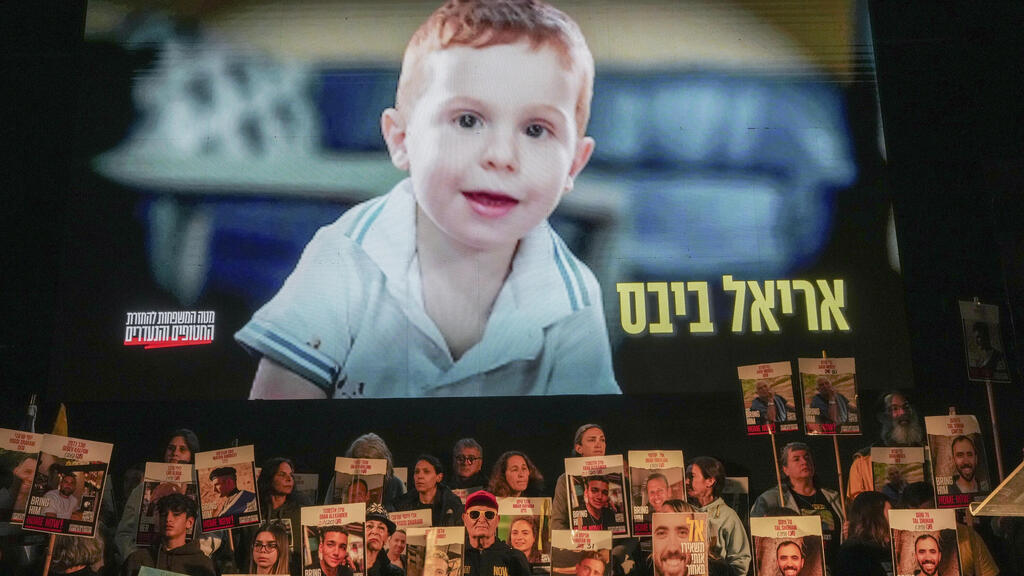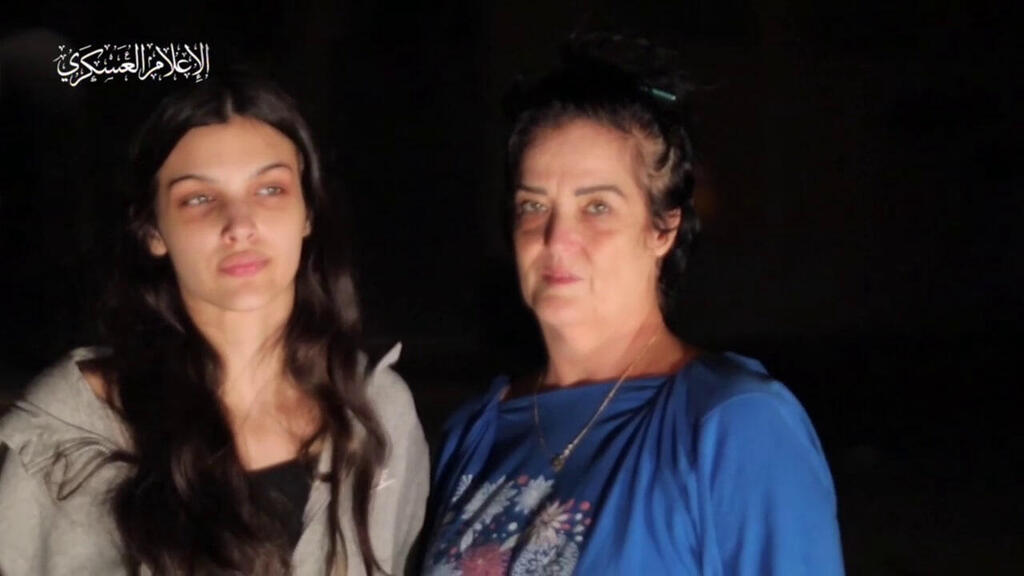The brutal murder of the Bibas children and the deception surrounding the supposed return of Shiri Bibas' body stand among the war's most devastating failures.
This tragedy is not just about the children, who became symbols of Israel's suffering—it's about the false hope our government allowed to take root, the humiliation it exposed and the undeniable weakness of the U.S. under the Biden administration and the American Jewish community. This is more than a painful loss; it is a catastrophe built on lies, deepening a national trauma that should never have happened.
4 View gallery


A woman mourns as four hostage bodies are released from captivity
(Photo: Yariv Katz)
For 16 months, Israelis, Jews and supporters around the world have prayed for the safe return of two redheaded babies—Kfir and Ariel Bibas—and their mother, Shiri.
Just six weeks later, on November 29, 2023, Hamas' al-Qassam Brigades announced that Shiri and her babies had been killed. At first, Hamas claimed they died in an Israeli airstrike during the fighting. Then, in a chilling reversal, they proudly admitted to murdering them.
(This Friday it was reported that the extremist Salafi group Al-Mujahedeen held the Bibas children and murdered them.)
The IDF said that it had informed the Bibas family of their deaths. Then, it added, it could be psychological warfare, as previous people were declared dead and then returned.
The following day, on November 30, Israel and Hamas extended the cease-fire by 24 hours. Hamas submitted a new list of women and children captives just minutes after the cease-fire expired, allowing negotiations to continue.
Reports soon surfaced that Israel was outraged—the new list contained only eight captives instead of the agreed-upon 10. Initially, Hamas had proposed releasing seven live captives along with the bodies of three executed hostages. Israel refused. At the time, intense speculation suggested those three executed hostages were the Bibas family.
President Isaac Herzog met with then-U.S. Secretary of State Antony Blinken that day.
"There are still around 150 hostages who are in Hamas hands in Gaza," Herzog told Blinken. "I would like to raise the plight of the Bibas family, the two young children, a 10-month-old baby, a four-year-old boy and their parents. Their whereabouts are unknown to us, and we are demanding their immediate release. It should be obvious that little toddlers will be released with their mother and hopefully with a father as soon as possible."
The cease-fire ended that day, and fighting resumed. Rumors of the Bibas family's deaths faded, and Blinken returned to Washington without taking any decisive action. Attention shifted back to the battlefield.
For over a year, the Bibas family remained a focal point. Posters of the two redheaded babies lined streets across Israel and cities worldwide, demanding their release. The hope that they might still be alive endured. But was it ever real?
If Israel rejected the return of their bodies in November 2023, why did the government allow the public to believe they could still come home?
Why did Israeli intelligence fail to confirm their fate sooner? Reports suggest that Israel had intelligence on many hostages but was unable to reach them without risking their execution. If the Bibas children had already been killed, why wasn't their fate disclosed? Why wasn't there a mission to recover their remains?
Did Israel's leadership believe that keeping the Bibas children in the public consciousness would sustain international pressure for hostage negotiations? Their innocent faces stirred deep emotions—was their image used to keep the hostage issue at the forefront, even when officials may have known the grim reality?
4 View gallery


A social media post grieving the loss of the red-haired Bibas boys and their mom Shiri
(Photo: Screenshot)
Since October 7, 2023, Israelis have endured relentless trauma. Hamas' brutal attack shattered the nation's sense of security and trust. The drawn-out agony surrounding the Bibas family's fate only compounded that suffering.
Did Israelis need to wait 16 months, clinging to false hope?
Selective rescue?
But there's more. Blinken failed to secure the release of the Bibas children, yet within days of their capture, the Biden administration managed to bring home two American women.
On October 20, Hamas released two American-Israeli hostages—Judith (Yehudit) Tai Raanan and her daughter, Natalie Shoshana Raanan. They were handed over to the Red Cross, returned to Israel and reunited with their family. Their release was reportedly on "humanitarian grounds."
The Raanans had been visiting Israel from Chicago for Yehudit's mother, Tamar Levitan's, 85th birthday. On October 7, they stayed in a guest apartment at Kibbutz Nahal Oz, where Levitan lived. The kibbutz was one of the hardest-hit areas. Dozens of residents were murdered or taken hostage, including many in homes in the first row near the border fence, where the Raanans were staying.
It was never clear what "humanitarian grounds" led to their release.
Hamas stated at the time: "In response to Qatari efforts, Al-Qassam Brigades released two American citizens (a mother and her daughter) for humanitarian reasons and to prove to the American people and the world that the claims made by Biden and his fascist administration are false and baseless."
Just days earlier, Biden had visited Israel. He condemned Hamas, calling its actions "pure, unadulterated evil" and describing the group as one "whose stated purpose for being is to kill Jews."
Get the Ynetnews app on your smartphone: Google Play: https://bit.ly/4eJ37pE | Apple App Store: https://bit.ly/3ZL7iNv
After their release, the Raanans thanked Biden for his help, telling him they were in good health. The president, in turn, thanked Qatar, crediting its mediation efforts for securing their freedom.
Yet at the time, 10 other Americans remained unaccounted for. Some were found murdered; others were not released until this latest hostage-for-cease-fire deal. Among them was Hersh Goldberg-Polin, who spent over a year in Hamas captivity, enduring torture before being brutally murdered.
And the Bibas babies? They were never freed.
If Biden could secure the release of two American women through Qatari mediation, why not two toddlers? Why weren't they prioritized from day one?
According to reports from the IDF and the National Center of Forensic Medicine, the Bibas children were murdered by Hamas in November, meaning on October 20, when the Raanans were released, they could have come home too.
Where were America's Jewish leaders?
This week, the Conference of Presidents of Major American Jewish Organizations held its 50th anniversary mission in Israel. Delegates met with Israeli leaders, toured the country's borders and emphasized their unwavering support.
In interviews, they spoke proudly of their deep ties to Israel and the millions they had raised over the past 16 months to aid the war effort. A key theme was the growing unity between Israel and the Jewish Diaspora in the wake of October 7.
Yet behind the scenes, some leaders expressed optimism—not about bringing the hostages home, but about Israel's potential peace agreements with Saudi Arabia and other Arab nations. One leader even claimed he had direct ties to the highest levels of these governments.
So why weren't those connections used to free the hostages?
Why did American Jewish organizations send protective vests—undeniably important—yet fail to stage relentless protests outside the White House, demanding the hostages' release?
 Maayan HoffmanPhoto: Joshua Pase
Maayan HoffmanPhoto: Joshua PaseConsider history. On December 6, 1987, 250,000 people marched in Washington, D.C., on the eve of the Reagan-Gorbachev summit. The "Freedom Sunday" rally was the largest demonstration in U.S. history for a Jewish cause. It was decisive in pressuring the Soviet Union to allow Jewish emigration.
The Soviet Jewry movement was one of the most effective Jewish advocacy campaigns in modern history. It succeeded because American Jews used their influence and refused to back down.
Today, American Jews are wealthier, more connected and closer to global power than ever.
So what happened? Was this failure the result of ineffective diplomacy—or a lack of urgency?
The Bibas children are gone.
However, even after the expected release of six more hostages this Saturday, more than 60 hostages will remain in Gaza.
This time, will the hope of their return be real?
- Maayan Hoffman is executive editor of ILTV News and a correspondent for The Media Line.




